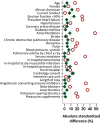Digoxin and 30-Day All-Cause Readmission in Long-Term Care Residents Hospitalized for Heart Failure
- PMID: 28501416
- PMCID: PMC5677225
- DOI: 10.1016/j.jamda.2017.03.016
Digoxin and 30-Day All-Cause Readmission in Long-Term Care Residents Hospitalized for Heart Failure
Abstract
Background: Digoxin use has been shown to be associated with a lower risk of 30-day all-cause hospital readmissions in older patients with heart failure (HF). In the current study, we examined this association among long-term care (LTC) residents hospitalized for HF.
Methods: Of the 8049 Medicare beneficiaries discharged alive after hospitalization for HF from 106 Alabama hospitals, 545 (7%) were LTC residents, of which 227 (42%) received discharge prescriptions for digoxin. Propensity scores for digoxin use, estimated for each of the 545 patients, were used to assemble a matched cohort of 158 pairs of patients receiving and not receiving digoxin who were balanced on 29 baseline characteristics. Hazard ratios (HRs) and 95% confidence intervals (CIs) for outcomes associated with digoxin among matched patients were estimated using Cox regression models.
Results: Matched patients (n = 316) had a mean age of 83 years, 74% were women, and 18% African American. Thirty-day all-cause readmission occurred in 21% and 20% of patients receiving and not receiving digoxin, respectively (HR, 1.02; 95% CI, 0.63-1.66). Digoxin had no association with all-cause mortality (HR, 0.90; 95% CI, 0.48-1.70), HF readmission (HR, 0.90; 95% CI, 0.38-2.12), or a combined endpoint of all-cause readmission or all-cause mortality (HR, 0.97; 95% CI, 0.65-1.45) at 30 days. These associations remained unchanged at 1 year postdischarge.
Conclusions: The lack of an association between digoxin and 30-day all-cause readmission in older nursing home residents hospitalized for HF is intriguing and needs to be interpreted with caution given the small sample size.
Keywords: Digoxin; heart failure; hospital readmission; nursing home.
Published by Elsevier Inc.
Figures


Similar articles
-
Renin-Angiotensin System Inhibition and Lower 30-Day All-Cause Readmission in Medicare Beneficiaries with Heart Failure.Am J Med. 2016 Oct;129(10):1067-73. doi: 10.1016/j.amjmed.2016.05.008. Epub 2016 Jun 2. Am J Med. 2016. PMID: 27262781 Free PMC article.
-
Digoxin use and lower risk of 30-day all-cause readmission in older patients with heart failure and reduced ejection fraction receiving β-blockers.Clin Cardiol. 2018 Mar;41(3):406-412. doi: 10.1002/clc.22889. Epub 2018 Mar 22. Clin Cardiol. 2018. PMID: 29569405 Free PMC article. Clinical Trial.
-
Digoxin Initiation and Outcomes in Patients with Heart Failure with Preserved Ejection Fraction.Am J Med. 2020 Oct;133(10):1187-1194. doi: 10.1016/j.amjmed.2020.02.040. Epub 2020 Apr 6. Am J Med. 2020. PMID: 32272101 Free PMC article.
-
Effect of Digoxin Therapy on Mortality in Patients With Atrial Fibrillation: An Updated Meta-Analysis.Front Cardiovasc Med. 2021 Oct 1;8:731135. doi: 10.3389/fcvm.2021.731135. eCollection 2021. Front Cardiovasc Med. 2021. PMID: 34660731 Free PMC article.
-
Association between depression and increased risk of readmission in patients with heart failure: a systematic review and meta-analysis.Minerva Cardiol Angiol. 2021 Aug;69(4):389-397. doi: 10.23736/S2724-5683.20.05346-3. Epub 2020 Sep 30. Minerva Cardiol Angiol. 2021. PMID: 32996309
Cited by
-
Heart Rate and Outcomes in Hospitalized Patients With Heart Failure With Preserved Ejection Fraction.J Am Coll Cardiol. 2017 Oct 10;70(15):1861-1871. doi: 10.1016/j.jacc.2017.08.022. J Am Coll Cardiol. 2017. PMID: 28982499 Free PMC article.
-
Renin-Angiotensin Inhibition and Outcomes in Nursing Home Residents With Heart Failure.Am J Ther. 2020 May/Jun;27(3):e235-e242. doi: 10.1097/MJT.0000000000000836. Am J Ther. 2020. PMID: 30299270 Free PMC article.
-
Length of stay and readmission in older adults hospitalized for heart failure.Arch Med Sci. 2020 Jan 8;17(4):891-899. doi: 10.5114/aoms.2019.89702. eCollection 2021. Arch Med Sci. 2020. PMID: 34336017 Free PMC article.
-
Medications and Prescribing Patterns as Factors Associated with Hospitalizations from Long-Term Care Facilities: A Systematic Review.Drugs Aging. 2018 May;35(5):423-457. doi: 10.1007/s40266-018-0537-3. Drugs Aging. 2018. PMID: 29582403
References
-
- Jencks SF, Williams MV, Coleman EA. Rehospitalizations among patients in the Medicare fee-for-service program. The New Englandjournal of medicine. 2009;360:1418–1428. - PubMed
-
- Rau J. Hospitals Face Pressure to Avert Readmissions. The New York Times; New York: 2012. http://www.nytimes.com/2012/11/27/health/hospitals-face-pressure-from-me.... Access date: December 2, 2012.
-
- Aronow WS, Ahn C. Elderly nursing home patients with congestive heart failure after myocardial infarction living in new york city have a higher prevalence of mortality in cold weather and warm weather months. J Gerontol A Biol Sci Med Sci. 2004;59:146–147. - PubMed
MeSH terms
Substances
Grants and funding
LinkOut - more resources
Full Text Sources
Other Literature Sources
Medical
Research Materials
Miscellaneous

